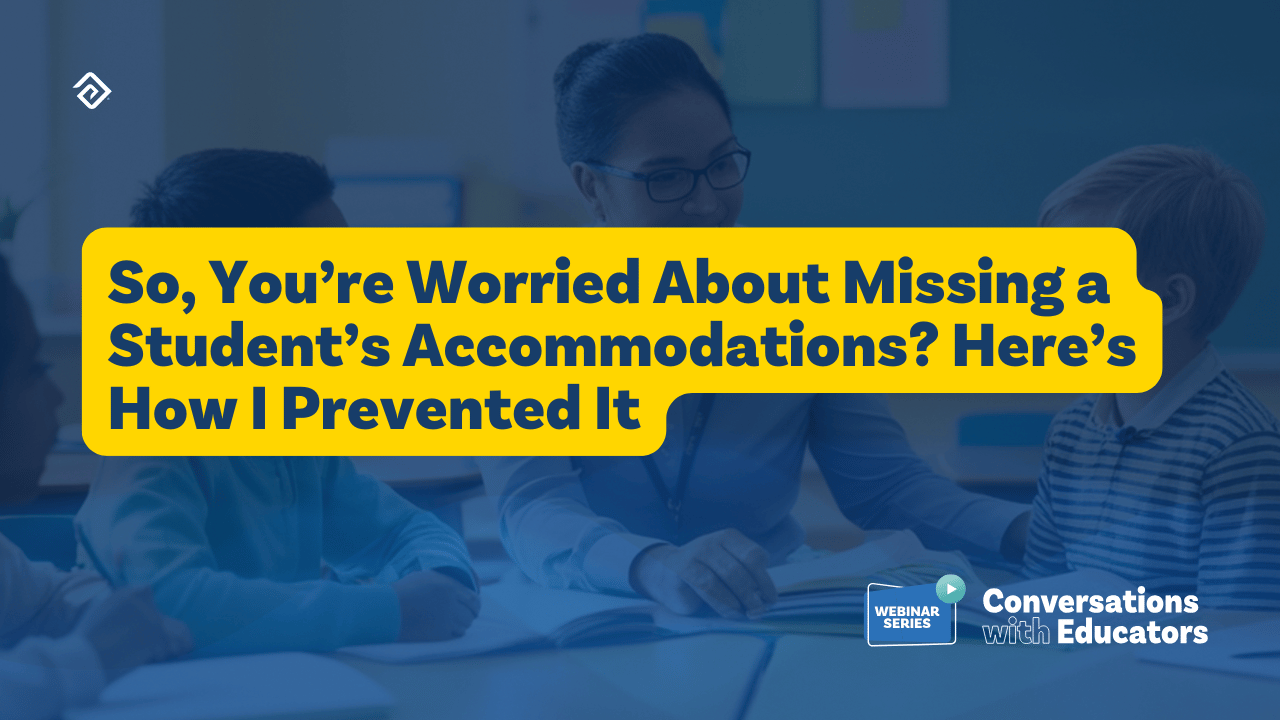So, You’re Worried About Missing a Student’s Accommodations? Here’s How I Prevented It
As districts juggle constant updates, new students, and changing plans, ensuring every accommodation is accurate requires clear systems, strong communication, and daily verification.
In our recent webinar, So, You’re Worried About Missing a Student’s Accommodations? Here’s How I Prevented It, Education Advanced’s Lara Miller and Max Gregory spoke with district leaders Erin Groeneveld, Kimberly Sass, and Sharonda Whorton about reducing errors, strengthening communication, and building systems that ensure every student receives the right accommodations.

Where Can Human Error Sneak Into Accommodations?
Sass: Students new to the district, or new to the state, come in with IEPs that look different than what we expect. Even if a plan is written today, that doesn’t mean everyone knows about it today. And because Florida tests year-round, we’re constantly adjusting to what’s new or changed.
Groeneveld: Before TestHound, everything relied on a human being. What people had access to, who told them what, if they remembered to make the change...it created a lot of pressure.
Whorton: We had far more testing incidents years ago. Human error was definitely a major factor, and since implementing stronger systems, those errors have dramatically decreased.
What Routines Help Districts Catch Mistakes Early?
Groeneveld: Florida’s Parent Educator Exceptional Resource (PEER) feeds directly into TestHound, so coordinators get alerts every day. But accepting an alert doesn’t mean the job is done. You still have to verify changes in the testing platforms or use the master and room accommodation reports.
At the beginning of the year, alerts come fast. Coordinators may need to use reports more heavily until things settle.
Sass: Some coordinators still want to check every IEP manually. We’re working to build trust in the system while reminding them to verify when something doesn’t look right.
How Do You Keep Communication Flowing Across Teams?
Whorton: You have to talk to people. If you don’t have what you need, you can’t sit back; you must go to that person directly.
Groeneveld: We encourage tight relationships between test coordinators and Exceptional Student Education (ESE) staff. Our weekly newsletter helps keep expectations clear, especially in the “in-between” weeks when alerts still matter.
Sass: Test coordinators aren’t the experts on accommodations, but they’re responsible for making sure they happen. We push them to build teams and rely on specialists, so the right decisions are made for each student.

What Collaboration Successes Have Made a Difference?
Groeneveld: When we moved to this system, the pressure lifted off our coordinators. They finally had visibility into every accommodation instead of relying on spreadsheets or phone calls.
Whorton: Integration with our special programs system has made a huge difference. Before this, spreadsheets caused so many problems. Now we may have only two or three incidents a year.
What Tools or Systems Act as Safety Nets?
Groeneveld: Training is key. We provide recorded training so coordinators can revisit processes, especially around interpreting alerts and activating accommodations.
Sass: Each year we add one new expectation as coordinators grow more comfortable. This year, we required giving test administrators the room accommodation report to tighten accuracy.
Whorton: Verification is non-negotiable. We compare everything against the official assessment document. If something is wrong, coordinators correct it and go back through verification before testing begins.
How Do Districts Ensure Coordinators Have What They Need?
Whorton: Before every administration, we send a survey asking if coordinators have everything: documentation, accommodations, supplemental aids. If they say “no,” we intervene immediately by contacting campuses or district program leads.
How Do You Balance Trusting the System With Staying Accountable?
Sass: There has to be a balance. Trust the system but verify every detail. When we say it’s working, we want them to believe us but still check when needed.
Groeneveld: The key is knowing what alerts mean. You can’t just accept them; you must understand their impact and confirm that the changes made it into the testing platform.
Final Thoughts
Reliable accommodations require more than good intentions; they require communication, verification, and systems that remove the burden from any one person. With strong routines and clear expectations, districts reduce the risk of missed accommodations and ensure every student gets what they need to show what they know.
If you missed the live session, you can watch the full webinar here to hear the complete conversation and access strategies for connecting evaluations to meaningful professional growth.
If your school is interested in new ways to improve the learning experience for children, you may also be interested in automating tasks and streamlining processes so that your teachers have more time to teach. Education Advanced offers a large suite of tools that may be able to help:
- Evaluation: A staff evaluation solution for documenting every step of the staff evaluation process, including walk-throughs, self-evaluations, supporting evidence, reporting, and performance analytics.
- Pathways: A graduation tracking tool that enables administrators and counselors to create, track, and analyze graduation pathways, ensuring secondary students stay on track to graduate.
- TestHound: Our test accommodation software helps schools coordinate thousands of students across all state and local K-12 assessments while considering various accommodations, such as for reading disabilities, physical disabilities, and translations.

More Great Content
We know you'll love





